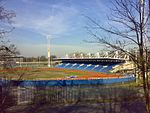Crystal Palace Dinosaurs

The Crystal Palace Dinosaurs are a series of sculptures of dinosaurs and other extinct animals, incorrect by modern standards, in the London borough of Bromley's Crystal Palace Park. Commissioned in 1852 to accompany the Crystal Palace after its move from the Great Exhibition in Hyde Park, they were unveiled in 1854 as the first dinosaur sculptures in the world. The models were designed and sculpted by Benjamin Waterhouse Hawkins under the scientific direction of Sir Richard Owen, representing the latest scientific knowledge at the time. The models, also known as Dinosaur Court, were classed as Grade II listed buildings from 1973, extensively restored in 2002, and upgraded to Grade I listed in 2007. The models represent 15 genera of extinct animals, only three of which are true dinosaurs. They are from a wide range of geological ages, and include true dinosaurs, ichthyosaurs, and plesiosaurs mainly from the Mesozoic era, and some mammals from the more recent Cenozoic era. Today, the models are notable for representing the scientific inaccuracies of early paleontology, the result of improperly reconstructed fossils and the nascent nature of the science in the 19th century, with the Iguanodon and Megalosaurus models being particularly singled out.
Excerpt from the Wikipedia article Crystal Palace Dinosaurs (License: CC BY-SA 3.0, Authors, Images).Crystal Palace Dinosaurs
Geological strata bridge, London Crystal Palace (London Borough of Bromley)
Geographical coordinates (GPS) Address Nearby Places Show on map
Geographical coordinates (GPS)
| Latitude | Longitude |
|---|---|
| N 51.4175 ° | E -0.067222222222222 ° |
Address
Hylaeosaurus
Geological strata bridge
SE19 2BB London, Crystal Palace (London Borough of Bromley)
England, United Kingdom
Open on Google Maps










